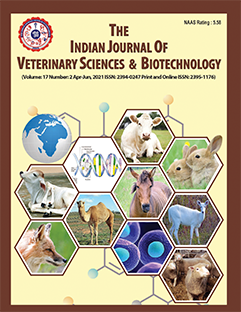Clinico-Pathology and Surgical Management of Leiomyosarcoma in Dog: A Case Report
DOI:
https://doi.org/10.48165/ijvsbt.21.6.35Keywords:
surgery, origin, leiomyosarcoma, develop, haemoglobinAbstract
A malignant smooth muscle tumour of mesenchymal origin, leiomyosarcoma can develop anywhere in the body. Smooth muscle is the site of this slow-growing, locally invasive, malignant tumour, which usually spreads slowly. Deep dermal smooth muscle, arrector pili, or vascular areas in the genital region can all give birth to dermal smooth muscle tumours (Enzinger et al., 2001). They are identified as angioleiomyomas and angio-leiomyosarcomas, pilo-leiomyomas and pilo-leiomyosarcomas, or genital leiomyomas and leiomyosarcomas, respectively (Liu and Mikaelian, 2003). Dermal smooth muscle tumours occur most frequently in dogs, cats and ferrets (Bahl et al., 2020). Surgical resection is the treatment most used for leiomyosarcoma. In humans and most other animals, leiomyosarcomas are relatively common in the visceral organs, especially the gastrointestinal tract and female genital tract, and in the spleen in dogs (Enzinger et al., 2001; Cooper and Valentine, 2002). Leiomyosarcoma rarely occurs in other organs; only a few cases in the oral cavity, oesophagus, and urinary bladder have been reported in humans and animals (Enzinger et al., 2001; Cooper and Valentine, 2002). Subcutaneous leiomyosarcoma is extremely rare in animals. This document puts on record a clinico-pathological study and surgical management of leiomyosarcoma in a dog.
Downloads
References
Aihara, N., Sugiyama, J., Baba, H., & Kamiie, J. (2019). Multiple cutaneous pleomorphic leiomyosarcoma in a dog. Journal of Veterinary Medical Science, 81(11), 1564–1566.*
Bahl, S., Jangir, B.L., & Narang, G. (2020). Histopathological and immunohistochemical evaluation of leiomyosarcoma in dog. Haryana Veterinarian, 59(SI), 109–111.*
Bailey, K.L., Kinsel, M.J., & Connell, K.A. (2003). Multiple cutaneous leiomyomas in the perineum of a horse. Journal of Veterinary Diagnostic Investigations, 15, 454–456.*
Bancroft, J.D., Suvarna, S.K., & Layton, C. (2013). Bancroft’s Theory and Practice of Histological Techniques (7th edn.). British: Churchill Livingstone Elsevier Ltd.*
Cooper, B.J., & Valentine, B.A. (2002). Tumours of muscle. In D.J. Meuten (Ed.), Tumours in Domestic Animals (4th edn., pp. 319–341). Blackwell, Iowa.*
Culling, C.F.A. (1974). Histopathological and Histochemical Techniques (3rd edn.). Butterworths, London.*
Dadhich, R. (2004). Pathological and haemato-biochemical studies of neoplasms in dogs (Canis familiaris) (Doctoral Thesis). Rajasthan Agricultural University, Bikaner, Rajasthan, India.*
Enzinger, F.M., Weiss, S.W., & Goldblum, J.R. (2001). Soft Tissue Tumours (4th edn., pp. 741–744). Mosby Year Book, St. Louis, MO.*
Finnie, J.W., Leong, A.S., & Milios, J. (1995). Multiple piloleiomyomas in a cat. Journal of Comparative Pathology, 113, 201–204.*
Jacobsen, M.C., & Valentine, B.A. (2000). Dermal intravascular leiomyosarcoma in a cat. Veterinary Pathology, 37(1), 100–103.*
Jung, J.Y., Kang, S.C., Park, D.S., Lee, E.S., Bae, J.H., & Kim, J.H. (2009). Cutaneous smooth muscle tumours in 3 dogs. Korean Journal of Veterinary Research, 49(1), 63–66.*
Liu, S.M., & Mikaelian, I. (2003). Cutaneous smooth muscle tumours in the dog and cat. Veterinary Pathology, 40, 685–692.*
Massi, D., Franchi, A., Alos, L., Cook, M., Di Palma, S., Enguita, A.B., & Tos, A.P.D. (2010). Primary cutaneous leiomyosarcoma: Clinicopathological analysis of 36 cases. Histopathology, 56(2), 251–262.*
Meuten, D.J. (2017). Tumours in Domestic Animals (5th edn.). John Wiley & Sons Inc., Germany.*
Nakamura, S.I., Iseda, S., & Une, Y. (2010). Subcutaneous leiomyosarcoma in a common squirrel monkey (Saimiri sciureus). Journal of Veterinary Medical Science, 72(5), 639–642.*
Yi, J.Y., Kim, Y.H., & Yoon, B.I. (2008). Primary subcutaneous leiomyosarcoma of the hamster hind leg. Journal of Veterinary Medical Science, 70(5), 517–520.*
Downloads
Published
Issue
Section
License
Copyright (c) 2025 Indian Journal of Veterinary Sciences and Biotechnology

This work is licensed under a Creative Commons Attribution-NonCommercial-NoDerivatives 4.0 International License.




